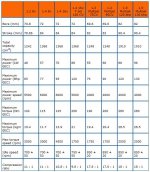Uncle Ed
New member
Hi folks,
The head gasket on the 2006 GP 1.4 8v finally collapsed, water into no 1 piston. 256k km done. Stripped the head off and sent to the local machinest who normally does the Fiat engines. We found that the head was done before elsewhere, via job number stamped on head. Reassembled the motor with new Victor Reintz gasket set, bolts, belts tentioners, etc. The guide on the forum "How to replace cam belt 1.2 8V" was srudied and used througout the exercise. The cam/crank locking tools are very expensive here, we made up own set using the dimentions as posted as part of the guide. Thanks guys, saved our day!!
We set up the locking plates, watched the videos for belt changes and confirmed as best we can that we have set up the timing correctly.
We also replaced oil and filter, new plugs, water in rad, etc. Assembled the tappet cover, coil pack and ECU in position and started engine.
Idled for 10 sec, switched off and started again, let it idle to allow oil to flow through, slight tappety noise heard. We gently raised the RPM slightly but as soos as we dropped the revs, there was a definate sound of valves touching a piston.
Back to checking rhe timing step by step, same sound again.
Now I'm at a loss.
Have arranged the machinist to come over tomorrow or Friday to give us some ideas.
My gut feel is the head is at it's limit and a new head next step.
What ideas from you experienced Fiat fundis?
Regards,
Ed
The head gasket on the 2006 GP 1.4 8v finally collapsed, water into no 1 piston. 256k km done. Stripped the head off and sent to the local machinest who normally does the Fiat engines. We found that the head was done before elsewhere, via job number stamped on head. Reassembled the motor with new Victor Reintz gasket set, bolts, belts tentioners, etc. The guide on the forum "How to replace cam belt 1.2 8V" was srudied and used througout the exercise. The cam/crank locking tools are very expensive here, we made up own set using the dimentions as posted as part of the guide. Thanks guys, saved our day!!
We set up the locking plates, watched the videos for belt changes and confirmed as best we can that we have set up the timing correctly.
We also replaced oil and filter, new plugs, water in rad, etc. Assembled the tappet cover, coil pack and ECU in position and started engine.
Idled for 10 sec, switched off and started again, let it idle to allow oil to flow through, slight tappety noise heard. We gently raised the RPM slightly but as soos as we dropped the revs, there was a definate sound of valves touching a piston.
Back to checking rhe timing step by step, same sound again.
Now I'm at a loss.
Have arranged the machinist to come over tomorrow or Friday to give us some ideas.
My gut feel is the head is at it's limit and a new head next step.
What ideas from you experienced Fiat fundis?
Regards,
Ed


